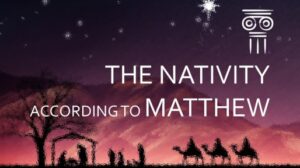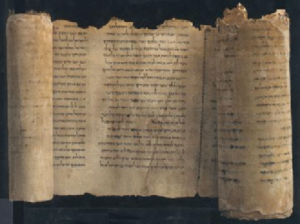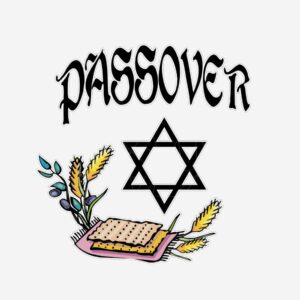Matthew’s Nativity – An Investigative Breakdown

Easy to forget, the Christmas Nativity story didn’t happen in a single night – it is a time-lapsed compilation of events that took place over many weeks, if not months. Two Gospels, Luke and Matthew, provide the accounts of the Nativity story.[1]
Luke’s account starts just before the birth of Jesus of Nazareth with an angelic birth announcement that Mary would give birth, even though she was a virgin, by way of the Holy Spirit in fulfillment of the Isaiah 7:14 prophecy. Marking the time in history with Augustus, Quirinius and Herod, it ends with baby Jesus being presented to God at the Temple.[2]
Matthew’s account starts with the angelic pregnancy announcement to Joseph that Mary would give birth to the Son of God. Next chapter jumps to the arrival of the wise men translated as “Magi” in some Bibles.[3]
Talmud references to Magi include other names they were known by: “fire worshippers” and “Guebers” from Persia.[4] Having a long history of persecuting the Jews, the Magi were well-known, feared and disliked.[5]
Magian priests, on the other hand, were highly regarded in the former Persian and Greek Empires for their mysterious abilities. Among them, they had a reputation for reading the stars and making accurate predictions.[6]
Plato and historian Strabo referred to the Magi as “king makers,” a reputation that had to be known to Herod. Greek Hellenism, prevalent in the Jewish culture, accepted all religions including Zoroastrianism, the main religion of the Magi.[7]
Openly embracing Hellenism, Herod incorporated Greek inscriptions and architectural features in the enhanced Jewish Temple. Causing great consternation to Jewish fundamentalists and their eventual execution, the event marked the beginning of the end for Herod.[8]
Setting the scene in Matthew, King Herod of Judea was in his Jerusalem palace rather than one of his other palaces in Herodium, Jericho and Caesarea.[9] Soon he would move to Jericho to live out his final days with a most miserable health condition…but not yet.[10]
As strange as it may seem, purveyors of mysticism were introduced by Matthew into the Jewish Nativity story of Jesus. Calling upon Herod at his palace, the Magi were promptly welcomed.
Shockingly, these Wise Men said something most alarming to King Herod. Revealing the reason for their visit, the Magi asked a question:
MT 2:2 “Where is He who has been born King of the Jews? For we have seen His star in the East and have come to worship Him.” When Herod the king heard this, he was troubled, and all Jerusalem with him.”(NKJV)
Any king, especially Herod, would be distressed when these king-maker Magi said they were looking for a newborn “King of the Jews.” Future tense was not used, rather present tense – he was already a king.
More disconcerting, the Magi said they had “come to worship Him” and it probably seemed very likely the people might want to do the same. Word leaked out to the people of Jerusalem of what the Magi had said and not surprisingly, they were also “troubled.”
At the very least, the rumor mill presented an air of uncertainty which always tends to worry a populace. If the child was the foretold Messiah, such speculation certainly stirred the pot even more.
Herod’s next action clearly demonstrates he believed the Magi when he “gathered all the chief priests and scribes together asking them where the Christ was to be born.”[11] Change in language is of special note: the Magi inquired about the birth of a “King of the Jews” while Herod’s quote uses the Greek word Christos meaning Messiah.
Whether this difference in language is attributable to the author of Matthew or if Herod concluded the King of the Jews meant the Messiah, it didn’t make any difference. Chief priests and scribes understood exactly what Herod was asking as evidenced by their specific answer.
Jewish chief priests and scribes – members of the Jewish leadership – reported to Herod that a Ruler was prophesied to be born “In Bethlehem of Judea.” Unambiguous, their answer included the quote from the prophecy of Micah 5:1/2.
MT 2:5-6 “…So they said to him, ‘In Bethlehem of Judea, for thus it is written by the prophet: “But you, Bethlehem, in the land of Judah, Are not the least among the rulers of Judah; For out of you shall come a Ruler Who will shepherd My people Israel.”’”(NKJV)
Previous mention of seeing ”his star” was initially not an attention-getting detail to the King. Believing the Magi’s declaration, this detail had been overshadowed by the bombshell announcement that there was another King of the Jews.
Undoubtedly, the Magi saw something in the night sky compelling them to travel hundreds of miles “from the East;” however, they didn’t say when they had seen “his star.” Herod soon realized these details were important – the time of the star’s appearance would serve to determine the child’s age.
Actions by Herod in the remainder of the account are telling. For this ruthless King with a reputation of murdering anyone who might be a threat, there was only one course of action – eliminate the threat. Every step taken from that point forward focused on this outcome.
Secretly Herod called the wise men to second meeting with the intent to determine from them what time the star appeared.[12] Not having received an answer to their initial question, the Magi agreed to meet with Herod again.
Information from the second meeting served to be useful to both parties. Answering the original question of the Magi regarding the location of the child, Herod “sent them to Bethlehem.” In return, Herod was generally able to determine when the Magi saw “his star” and thus the age of the child.[13]
Worshiping no one or thing, Herod set the trap. Cunningly, Herod said to the Magi, “when you have found Him, bring back word to me, that I may come and worship Him also.”
MT 2:9-10 “When they heard the king, they departed; and behold, the star which they had seen in the East went before them, till it came and stood over where the young Child was. When they saw the star, they rejoiced with exceedingly great joy.”(NKJV)
After the follow-up meeting with Herod, the Magi saw a second appearance of the “star,” a definitive clue that opens the door for the science of astronomy to plausibly explain it. In a very rare scenario during an 18-month period in 3-2 BC, an extremely rare series of conjunctions occurred in the cosmos centered around Jupiter.
June 17, 2 BC, about nine months after the first Jupiter-Venus very close conjunction, Jupiter, known as the king star, came into an occultation conjunction (overlapping/fused) with Venus, known as the Queen or mother star. Much bigger and brighter, the two brightest stars in the sky formed one star.[14]
Jupiter entered a retrograde and appeared in the South over Bethlehem. Finding the child in Bethlehem was probably not difficult – in a small town, everyone knows what’s what, just ask. Finding Jesus in a house, the Magi “fell down and worshiped Him.” And when they had opened their treasures, they presented expensive gifts to Him: gold, frankincense, and myrrh.”[15]
Now it becomes clear why Herod wanted to determine the age of the child. Realizing he had been deceived when the Magi avoided him, true to the reputation of Herod’s ruthless, cruel profile, he commanded all the children 2 years old and younger in the districts of Bethlehem to be killed.
MT 2:16 “Then Herod, when he saw that he was deceived by the wise men, was exceedingly angry; and he sent forth and put to death all the male children who were in Bethlehem and in all its districts, from two years old and under, according to the time which he had determined from the wise men.”(NKJV)
More than capable of such evil deeds, there were no bounds for Herod’s diabolical behavior. Torturing people for mere suspicions, Herod killed countless Jews, not to mention killing his brother, three sons, a former Jewish High Priest, and plotted to have all the “principal men” of Judea killed upon his own death.[16]
King Herod’s drastic action confirmed five points the King believed: the Magi’s declaration; the Jewish religious experts, the Micah prophecy; Christos had been born…and in Bethlehem.
Oft overlooked is a key critical detail provided by Matthew after King Herod died. Archelaus, King Herod’s son, became his successor, a fact that is consistent with secular history.[17]
At least 20 specific details are laid out in a logical sequence in 22 verses, much that is corroborated by history and science. Does this strengthen the credibility to Matthew’s Gospel account about the birth of Jesus of Nazareth?
Updated December 20, 2023.
This work is licensed under a Creative Commons Attribution-NonCommercial-NoDerivatives 4.0 International License.
REFERENCES:
All Bible quotes are from the New King James Version.
[1] McLeay, Simon. StPeters. “The Nativity According to Matthew.” image. 2018. <https://www.stpeters.org.nz/media/_home_slide_image/th-18-12-02-the-nativity-matthew.jpg>
[2] Luke 1:5; 2.
[3] Matthew 2:1. Netbible.org. <http://classic.net.bible.org/verse.php?book=Mat&chapter=2&verse=1>
[4] Soncino Babylonian Talmud. Ed. Isidore Epstein. The Soncino Press. 1935-1948. Sanhedrin 98a. <https://israelect.com/Come-and-Hear/sanhedrin/sanhedrin_98.html#98a_22> Sanhedrin 74b. <https://israelect.com/Come-and-Hear/sanhedrin/sanhedrin_74.html> “Babylonia.” Jewish Encyclopedia. 2011. <http://www.jewishencyclopedia.com/articles/10263-magi> Cicero, M. Tullius. Divination. 44 BC. 1.46. <http://www.perseus.tufts.edu/hopper/text?doc=Perseus%3Atext%3A2007.01.0043%3Abook%3D1%3Asection%3D46> Cicero. Divinations. 1.2.
[5] Segal, Eliezer. “The Menorah and the Magi.” Sources. 1997. <https://people.ucalgary.ca/~elsegal/Shokel/971219_MagiMenorah.html> Missler, Chuck. “Who Were the Magi?” Idolphin.org.1999. <http://www.ldolphin.org/magi.html>
[6] “Zoroastrianism.” Jewish Encyclopedia. 2011. <http://www.jewishencyclopedia.com/articles/15283-zoroastrianism>
[7] Plato. Alcibiades 1. Trans. W.R.M. Lamb. c. 390 AD. 1 121e-1232. <http://www.perseus.tufts.edu/hopper/text?doc=Perseus%3Atext%3A1999.01.0176%3Atext%3DAlc.%201%3Asection%3D122a> Herodotus. The Histories. Book 1, Chapters 107-122. <http://www.perseus.tufts.edu/hopper/text?doc=Perseus:text:1999.01.0126>Herodotus. The Histories. Book 3, Chapters 30, 60-79. Missler. “Who Were the Magi?” Plato. Republic. Trans. Paul Shorey. 9.572e. <http://www.perseus.tufts.edu/hopper/text?doc=Perseus%3Atext%3A1999.01.0168%3Abook%3D9%3Asection%3D572e> Strabo. Geography. Book 11.9 n.d. <https://web.archive.org/web/20221018120345/https://www.perseus.tufts.edu/hopper/text?doc=Perseus:text:1999.01.0198:book=11:chapter=9&highlight=magi> Polybius. Histories. Book 34, Chapter 2. <http://www.perseus.tufts.edu/hopper/text?doc=Perseus:text:1999.01.0234:book=34:chapter=2&highlight=magi> Herodotus.” Encyclopædia Britannica. 2018. <https://www.britannica.com/biography/Herodotus-Greek-historian> Herod the Great.” Livius.org. Ed. Jona Lendering. 2017. <http://www.livius.org/articles/person/herod-the-great/?> “Edom (ē`dŏm), Idumaea, or Idumea.” The Free Dictionary. 2017. <http://www.bible-history.com/herod_the_great> Bunson, Matthew. Encyclopedia of the Roman Empire. “Idumaea.” 2002. <https://archive.org/details/isbn_9780816045624> “Herod the Great Biography.” TheFamousPeople. image. n.d. <https://www.thefamouspeople.com/profiles/herod-the-great-37596.php> Diogenes Laertius. Lives of Eminent Philosophers. 8.1; 9/7. <http://www.perseus.tufts.edu/hopper/text?doc=Perseus:text:1999.01.0258:book=9:chapter=7&highlight=Magians%2C> “Pythagoras.” Encyclopædia Britannica. 2018. https://www.britannica.com/biography/Pythagoras> “Cyrus takes Babylon.” Livius.org. Ed. Jona Lendering. 2018. <http://www.livius.org/sources/content/herodotus/cyrus-takes-babylon> “Democritus.” Encyclopædia Britannica. 2018. <https://www.britannica.com/biography/Democritus> Diogenes. Lives. 9.7.
[8] Burrell, Barbara; Gleason, Kathryn L.; Netzer, Ehud. “Uncovering Herod’s Seaside Palace. BAS Library. 1993. <https://www.baslibrary.org/biblical-archaeology-review/19/3/7> Geva, Hillel. “Archaeology in Israel: Jericho – the Winter Palace of King Herod.” Jewish Virtual Library. 2019. <https://www.jewishvirtuallibrary.org/jericho-the-winter-palace-of-king-herod> “Herodium-King Herod-s Palace-Fortress.” Israel Ministry of Foreign Affairs. 2000. < https://mfa.gov.il/mfa/israelexperience/history/pages/herodium%20-%20king%20herod-s%20palace-fortress.aspx> Josephus, Flavius. Antiquities of the Jews. Trans. William Whitson. Book XV, Chapter XI. <http://books.google.com/books?id=e0dAAAAAMAAJ&printsec=frontcover&source=gbs_ge_summary_r&cad=0#v=onepage&q&f=false> Josephus, Flavius. Wars of the Jews. Trans. William Whitson. Book I, Chapter XXI. <http://books.google.com/books?id=e0dAAAAAMAAJ&printsec=frontcover&source=gbs_ge_summary_r&cad=0#v=onepage&q&f=false> “Herod the Great.” Bible History Online. 2016. <http://www.bible-history.com/herod_the_great> “Herod.” Jewish Virtual Library. n.d. <https://www.jewishvirtuallibrary.org/herod>
[9] Josephus. Antiquities. Book XVII, Chapter VI.
[10] Josephus. Antiquities. Book XV, Chapter VIII; Book XVI, Chapter V; Book XVII, Chapters VI; VIII. Josephus. Wars. Book I, Chapter XXI. “Hellenism” Jewish Encyclopedia. 2011. <http://www.jewishencyclopedia.com/articles/7535-hellenism>
[11] Matthew 2:4. Greek text. NetBible.org. <http://classic.net.bible.org/verse.php?book=Mat&chapter=2&verse=4>
[12] Matthew 2:7.
[13] Matthew 2:8, 16.
[14] Phillips, Tony. “A Christmas Star for SOHO.” NASA Science | Science New. 16 May 2000. <http://web.archive.org/web/20170516003444/https://science.nasa.gov/science-news/science-at-nasa/2000/ast16may_1> “Venus And Jupiter Will Pass 42 Arc seconds Apart On May 17.” Press Release – Marshall Space Flight Center. SpaceRef.com. 2000. <http://www.spaceref.com/news/viewpr.html?pid=1819> Carroll, Susan S. “The Star of Bethlehem: An Astronomical and Historical Perspective.”1997. Twin Cities Creation Science Association. n.d. <http://www.tccsa.tc/articles/star_susan_carroll.pdf>
Martin, Ernest L. The Star of Bethlehem – The Star That Astonished the World. Associates for Scriptural Knowledge. 2003. Chapter 4. Larson, Frederick A. The Star of Bethlehem. 2014. <http://www.bethlehemstar.net/setting-the-stage/why-are-we-hearing-this-now> Haley, A. S. “The Star of Bethlehem and the Nativity.” Anglican Curmudgeon. 2009. <http://web.archive.org/web/20171016111146/http://www.newmanlib.ibri.org/Papers/StarofBethlehem/75starbethlehem.htm> Bunson, Matthew. Encyclopedia of the Roman Empire. “Jupiter.” 2002. <https://archive.org/details/isbn_9780816045624>
[15] Matthew 2:11. NKJV. Larson, Frederick A. The Star of Bethlehem. 2014. <http://www.bethlehemstar.net/setting-the-stage/why-are-we-hearing-this-now> “Retrograde.” Encyclopædia Britannica. 2023. <https://www.britannica.com/topic/human-body-systems-2237111>
[16] Josephus. Antiquities. Book XV, Chapters III-VII, IX, XIII, XVI; Book XVI, Chapter XI; Book XVII, Chapters VI, IX. Josephus. Wars. Book I, Chapters X, XXVII, XXXIII.
[17] Matthew 2:22.


 Final days of Jesus of Nazareth took place during the annual Passover observance in
Final days of Jesus of Nazareth took place during the annual Passover observance in